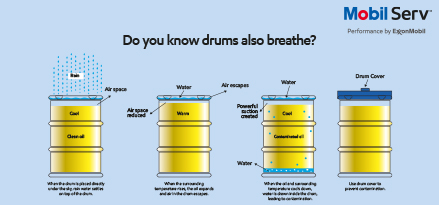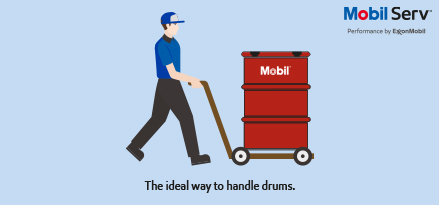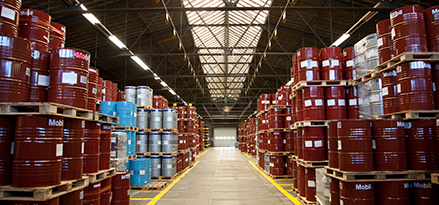If not handled and stored properly, lubricating oils and greases can deteriorate or become contaminated. You can find a detailed explanation of indoor, outdoor and bulk storage recommendations here or contact your distributor for more information.
Shelf life represents the time period during which a stored product, such as lubricating oils and greases, can continue to be used without quality-control checks to verify performance attributes.
Typically, equipment builders’ manuals include a recommendation on oil change intervals and other related maintenance schedules. We also recommend using tools such as Mobil Serv℠ Lubricant Analysis to determine whether in-service oil requires replacement. Read more about our Mobil Serv Lubricant Analysis program or contact your distributor for more information.
There is a fundamental difference between product life in storage and product life in service. During storage, the packaged product generally remains motionless for extended periods, and can be exposed to cyclic variation in temperature and other environmental conditions such as vibration, which can impact the components of the formulation or potentially allow ingress of contaminants from the environment – both of which have the potential to affect the product’s performance characteristics. However, when the lubricant is in service, it is exposed to the dynamic conditions of the lubricated system (e.g., circulation, splashing, churning, etc.).
Once a product has been placed in service, its suitability for continued use becomes a function of other factors.
In general, the recommended shelf life for oils and greases is five years, when stored properly in the original sealed containers.However, a variety of factors may impact recommended shelf life.
In general, the recommended shelf life for Mobil-branded greases is five years when stored properly in the original sealed containers.
The lubricating oil and grease shelf life recommendation provided by ExxonMobil applies to products stored in the original sealed containers in a sheltered environment under good housekeeping conditions and at typical ambient temperatures.
Be sure to clean up all excess grease and dirt from the bearing and surrounding areas. Excess grease and dirt on external surfaces acts as an insulator and prevents heat dissipation. Additionally, excess grease on the external surfaces and floors can introduce a safety hazard to personnel.
Ahead of applying a new grease, thoroughly clean – or flush out – the previous grease from the bearing. This avoids compatibility issues and helps ensure that the new grease can perform at an optimum level.
If this cannot be carried out, mitigating actions should focus on minimizing the amount of the displaced grease remaining in the application, such as by increasing relubrication frequency to facilitate a purge of old grease in a timely manner.
Mixing different greases, even those with similar thickener types, can sometimes lead to ineffective lubrication resulting in damage of the lubricated components. If not spotted soon enough this may lead to equipment failure.
Mixing different types of greases can sometimes lead to incompatibility problems. Grease incompatibility results from chemical interactions between the thickener or additive systems of the dissimilar greases. In some cases, grease incompatibility can lead to equipment failure or damage of the lubricated components.
Mixtures of incompatible greases will exhibit either excessive hardening or softening relative to the consistency of the individual pure greases. The hardening or softening tendencies of the mixture will generally become more pronounced as the operating temperature increases or as the rate of shearing on the grease mixture increases.
Incompatible greases may also exhibit excessive oil separation or “bleeding” tendencies at higher temperatures.
Many rolling element bearings require relubrication of small quantities of grease between grease flushing intervals. This is best done with a low-pressure grease gun. If seals are in good condition, the quantity of grease needed may be small and infrequent.
- Check the amount of grease in the bearing – remove fitting or grease plug to allow excess grease to come out.
- Check bearings and seals for excess leakage.
- Apply a few “shots” of grease at a time.
Greases may show deterioration in one or more of the following ways:
- Excessive oil separation
- Some “bleed” is normal and required
- Significant change (>25 percent) in the grease consistency as measured by worked or unworked penetration. Grease consistency affects the ease of grease application, low-temperature performance and stay put performance, all critical characteristics ensuring proper grease lubrication. In technical terms, grease’s consistency is referred to as its NLGI Grade – from NLGI 000 (semifluid) to NLGI 6 (block – very firm)
- Significant change in color or odor
- Noticeable change in texture
If you have ever opened a grease container and found a puddle of free oil, you almost certainly may have wondered whether the grease is still fit for use. The phenomenon described is called static oil bleed. Some in-depth review of grease fundamentals is needed to comprehend if it is inherent to greases.
Best storage and handling practices
Proper breathing, staying upright, adequate shelter - just like you, your lubricants need care and attention ensure there performance.

Follow right storage practices so you - and drums - can breathe easier

Upright is just right. Always keep drums standing up during transportation.

Drums have your lubricant needs covered. Drums should be covered as well. Ensure they are sheltered when stored.

Remember, three and nine is always fine - the ideal way to store your oil drums.

